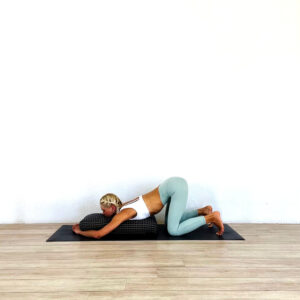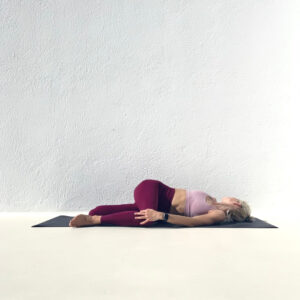Information



Asana practice can teach us a lot more than just focusing on our physical ability. Although it is a part of the yoga philosophy, practicing asanas can bring us in closer connection to our true essence and away from our daily distractions. Whilst there are many different styles now accessible to us, and we see dynamic practices often, it is also important to emphasise on the need to create balance by also introducing more gentle styles of practice also.
A therapeutic style practice consists mostly of passive asanas, which held over a longer duration, can help us release more than just physical tension, such as emotional and mental stress. A focus on healing can also be experienced in these types of practices. This is also one of the core aspects of yin yoga style. When practicing a more gentle and restorative sequence, we learn to be patient; to breathe through the tension and surrender to our current state without judgement, but instead with understanding and compassion. Applying a therapeutic approach can help calm the nervous system, particularly the sympathetic NS, which activates with dynamic movements or stress and anxiety.
This sequence is a gentle, yin type practice which brings us into a state of mental stillness and release of constant chatter of the thoughts. Our thinking greatly affects our emotions, so cultivating a less active mental state can also provide us with the space required to tune into our emotions and observe exactly what is going on.
Practice these asanas in the order displayed and hold for the time mentioned, or as it feels ok for you. Please always remember that you should never feel any pain in your practice and if you do at any point, modify the asana by using props or move onto the next one. If you are pregnant, have any injuries, past or recent surgery, please check with your GP first.

Mandukasana is a hip opening asana which primarily targets the inner thigh area. It can be quite an intense stretch, so go only as far as it feels ok for your body. The hips are part of Swadisthana, the sacral chakra. This is the energy centre that represents creativity, feminine energy and how we process feelings. So Mandukasana gives us the opportunity to release not only the physical tension from this area, but also any stagnant emotions that may block our sense of joy and inspiration for life. Props can also be used, such as bolsters to rest the chest on or under the inner thigh area. Hold this asana for 1.5-3 minutes (or as it feels ok for you).

Anahatasana is also known in hatha yoga as Uttana Shishosana (extended puppy pose). This asana provides a lovely stretch to the back muscles and the spine. It also focuses primarily on opening the chest and shoulder areas. As its yin yoga name (Anahatasana), this posture relates to Anahata, the heart chakra. This energy centre is our connection to the ability to give and receive unconditional love and cultivate acceptance and trust. Therapeutically, it can bring awareness to healing by letting go of any emotional baggage we hold onto which can block our ability to be open to the idea of love in all forms. A bolster can be used under the chest, and there is the option to place the forehead or chin down. Hold this asana for 2-3 minutes (or as it feels ok for you).

Often underestimated, Balasana is one of the most therapeutic asanas. This posture is an opportunity to pause, reflect and go inward. It provides us with some time for some introspection, by curling in a fetal position (traditionally this asana brings the hands to the feet). The variation shown provides an lovey stretch to the back muscles and arms. Hold this asana for 3 minutes (or as it feels ok for you).

Another beautiful hip opener, Upavistha Konasana targets the inner thighs, hamstrings and glutes, therefore the hip extensors. Just like Mandukasana, this posture is in the energetic category of the sacral chakra, once again inviting us to release any stagnant emotions and go inward to find a space of calm and tranquility. Variation can be done by placing a block under the buttocks to elevate the hips and support the forward fold, or blocks under the forearms. Hold this asana for 1.5-3 minutes (or as it feels ok for you).

Every spinal twist detoxifies the digestive organs. Supta Matsyendrasana is a more gentle way into a twist, because the spine is on the ground, making the twist slightly easier than if seated. This asana relates to Manipura, the energy centre of self-confidence and will-power, tuning us into our own inner strength. But it also brings attention to Anahata, opening the chest and shoulders. Ensure that both shoulders remain on the floor during the twist. There is also the option of straightening the legs or wrapping the top leg around the other to increase the twist effort for the body. Hold this asana for 1.5-2minutes on each side (or as it feels ok for you).

Halasana is one of the most introspective asanas of all, taking us on an inner journey. It activates Vishudi, the throat chakra which represents communication and ability to express oneself freely. Physically, Halsana stretches the back muscles, improves flexivility of the spine and it stimulates the digestive organs. Therapeutically, this is one of the most calming asanas for the nervous system, due to its intense stretch of the cervical spine. Be gentle with this asana, and as an option you can use blocks or a chair to rest your feet on if they don’t reach the ground. Practice a variation of fish pose after this as a counter pose for the cervical spine. Hold this asana for 1.5 minutes (or as it feels ok for you).

Viparita Karani is a lovely and gentle inversion, boosting circulation in the legs. Usually done towards the end of an asana practice, this posture is also calming for the nervous system and for the whole body. There is an option to place a block or bolster under the sacrum. Hold this asana for 3-5 minutes (or as it feels ok for you).

This is one of the key asanas in any asana practice. Whilst some people choose to skip Savasana, I advise everyone to not to do. Savasana is the cherry on top, the asana that brings everything into balance after every practice. It is an invitation to surrender and simply let ourselves be in awareness of the present moment, without any physical or mental effort. End your practice with 10-15 minutes of Savasana.